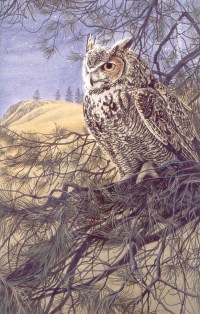| ________________
CM . . .
. Volume XXI Number 14 . . . . December 5, 2014
excerpt:
Voices from the Wild: An Animal Sensagoria combines the poetic text of prolific writer, David Bouchard, with the exquisite artwork of painter Ron Parker. In the book, each of the senses is featured through animals with special abilities related to each sense. Five separate poems focus upon five different animals for each of the senses. For instance, for the sense of smell, a separate poem and painting centre on the wolf, the grizzly bear, wildebeests, the lynx, and the mule deer. The paintings are faultless. They are a visual delight and animal lovers will enjoy the artwork immensely. Unfortunately, the marriage of art and text is not seamless. For instance, the Great Horned Owl is depicted upon the branches and needles of a pine tree, whereas in the text, that same owl says, “Sit beside me for a moment / In this oak tree any night” [my emphasis]. Bouchard has the koala saying, “But do They know that unlike most / My pouch is on my back?” This is not true. Certainly, older koala babies ride on the mother’s back, but not in a pouch. A koala has what is sometimes referred to as a “backward-facing” pouch but it is located on the abdomen of the animal, not on the back. Even without such inaccuracies, the poems generally lack appeal. As a book for children, I doubt that many young readers will derive much enjoyment or information from the poems. Given such realistic paintings, I cannot understand why Bouchard chose to anthropomorphise the animals. What’s more, he not only has them thinking and talking like humans, he has them talking to humans—to the painter who has captured them in the artwork. It all seems to me a confusing, sentimental, and indulgent way to proceed. The excerpt above (at the start of this review) is a good example of the indulgent text—Bouchard seemingly indulging the artist, Parker—with a moose apparently recognizing and praising Parker’s keen observational abilities. The book is largely spoiled by the sentimental, inappropriate words that Bouchard puts in the mouths of the animals: “I’m just grateful that you care,” says the otter to the painter. “I have seen how much you care,” says the hummingbird to the painter. The text that is most interesting and most valuable is that which has been pushed to the final few pages of the book—the five pages of informational notes about the various animals. This nonfiction text is far better suited as a match for the detailed, realistic artwork. The book would be a better one if the paintings were accompanied by the end pages informational text, rather than the poems. The artwork is good enough that many readers will be happy to flip from page to page to savour the magnificent paintings. On the strength of the paintings alone, the book is worthy of recommendation. Unfortunately, however, the poems add little and will lack wide appeal. The book would be better as a portfolio of paintings without any accompanying text. It would have been better still if it were presented as an informational book devoid of poetry but filled with the interesting details contained over the last few pages. Recommended with Reservations. Dr. Gregory Bryan is a member of the Faculty of Education at the University of Manitoba. He specialises in literature for children.
To comment on this title or this review, send mail to cm@umanitoba.ca.
Copyright © the Manitoba Library Association. Reproduction for personal use is permitted only if this copyright notice is maintained. Any
other reproduction is prohibited without permission.
CM Home | Next Review | Table of Contents for This Issue - December 5, 2014 | Back Issues | Search | CM Archive | Profiles Archive |

 Parker’s paintings are reminiscent of Canada’s best-known naturalist painter, Robert Bateman. The detailed, colourful artwork is a delight. The photo-realism style portrays the animals in such a way that they appear almost to dominate their surroundings. It is as if Parker is magnifying the majesty of each of the animals. This style works well in a book in which the focus is upon the special abilities of each animal—abilities far beyond those possessed by the human beings with whom they are compared.
Parker’s paintings are reminiscent of Canada’s best-known naturalist painter, Robert Bateman. The detailed, colourful artwork is a delight. The photo-realism style portrays the animals in such a way that they appear almost to dominate their surroundings. It is as if Parker is magnifying the majesty of each of the animals. This style works well in a book in which the focus is upon the special abilities of each animal—abilities far beyond those possessed by the human beings with whom they are compared.